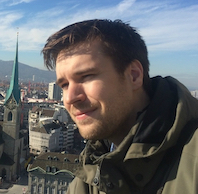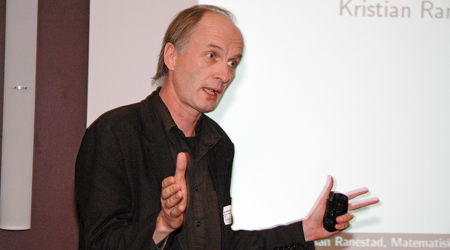Seminarer - Side 2
As a consequence of the S-duality conjecture, Vafa and Witten conjectured certain symmetries concerning invariants derived from spaces of vector bundles on a closed Riemannian four-manifold. For a smooth complex projective surface X, a satisfying mathematical definition of Vafa-Witten invariants has been given by Tanaka and Thomas. Their invariants are a sum of two parts, one of which can be defined in terms of moduli spaces of stable vector bundles on X. Focusing on this instanton part of the VW invariants one can ask how it changes under blowing up the surface X. I will discuss joint work with Oliver Leigh and Yuuji Tanaka that answers this question.
I will explain how a recent “universal wall-crossing” framework of Joyce works in equivariant K-theory, which I view as a multiplicative refinement of equivariant cohomology. Enumerative invariants, possibly of strictly semistable objects living on the walls, are controlled by a certain (multiplicative version of) vertex algebra structure on the K-homology groups of the ambient stack. In very special settings like refined Vafa-Witten theory, one can obtain some explicit formulas. For moduli stacks of quiver representations, this geometric vertex algebra should be dual in some sense to the quantum loop algebras that act on the K-theory of stable loci.
Abstract (PDF)
In 80s Weibel observed that K-theory is homotopy invariant on Fp-schemes up to p-torsion. His main tool was the action of the ring Witt vectors on nil-K-groups: NKi(R) = Ker(Ki(R[t]) → Ki(R)). We will revisit the proof and check that the same result holds for all finitary localizing invariants.
I will explain how motivic homotopy theory can be used to attack problems regarding finite projective modules over smooth affine k-algebras. I will recall in particular the foundational theorem of Morel and Asok-Hoyois-Wendt, and the construction of the Barge-Morel Euler class. Time permitting, I will explain recent progress on Murthy's splitting conjecture.
Abstract (PDF)
I will discuss the question in the title. This is joint work with Alex Degtyarev and Ilia Itenberg. This will be a talk involving very classical topics in algebraic geometry. I will try to make the talk accessible to students at master- and PhD level.
Stable polynomials are a multivariate generalization of real-rooted univariate polynomials. This notion of stability for hypersurfaces can be extended to lower-dimensional varieties, giving rise to positively hyperbolic varieties. I will present results showing that tropicalizations of positively hyperbolic varieties are very special polyhedral complexes with a rich combinatorial structure. This, in particular, generalizes a result of P. Brändén showing that the support of a stable polynomial must be an M-convex set.
In a famous paper, Geir Ellingsrud and Stein Arild Strømme use the Atiyah-Bott localization theorem in equivariant cohomology to compute the number of complex twisted cubics on a complete intersection. Motivated by results from A1-homotopy theory there is a new way of doing such enumerative counts which works over an arbitrary base field, not only the complex numbers. Recently, Marc Levine proved a version of Atiyah-Bott localization for this new way of counting.
In the talk I will recall the classical Atiyah-Bott localization theorem and explain how one can use it in enumerative geometry. Furthermore, I will explain how this new way of counting works and present some results about twisted cubics on complete intersections counted this way. This is based on joint work with Marc Levine.
For the second talk, I will talk about how to relate relative Gromov--Witten invariants with relative periods via relative mirror symmetry and, given a degeneration, how relative periods and (absolute) periods are related on the mirror side.
A cohomology class of a smooth complex variety of dimension n has coniveau ≥c if it vanishes in the complement of a closed subvariety of codimension ≥c, and has strong coniveau ≥c if it comes by proper pushforward from the cohomology of a smooth variety of dimension ≤n−c. We show that these two notions differ in general, both for integral classes on smooth projective varieties and for rational classes on smooth open varieties. This is joint work with Olivier Benoist.
A graded Artinian Gorenstein ring A is a quotient of a polynomial ring S with the apolar ideal of a homogeneous form. The Betti numbers of the resolution of A as an S-module are invariants to the homogeneous form. In joint work with Michal and Gregorz Kapustka, Hal Schenck, Mike Stillman and Beihui Yuan, we use these Betti numbers to describe a stratification of the space of quartics in four variables.

